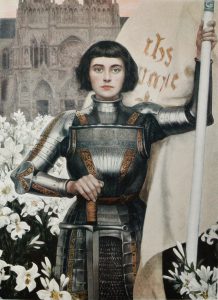 Joan of Arc
Joan of Arc
Le Ditie de Jehanne d’Arc, or The Tale of Joan of Arc, was written by Christine de Pisan in 1429. This was during the Late Middle Ages, and towards the end of the Hundred Years’ War, which the piece focuses on.
The war took place from 1337 to 1453 between the French House of Valois and the British House of Plantagenet over the right to the French throne. King Charles IV of France died in 1328 without any sons or brothers who could serve as immediate heirs. His closest male relative was his sister Isabella’s son, Edward III of England. This claim was rejected by the French, however, both because they did not want an English king, and because they said that Isabella could not pass on a right to the throne to Edward when she was not able to possess it herself.
Instead, it went to Charles IV’s patrilineal cousin, Philip, Count of Valois, who became King Philip VI of France. Philip was the first king from the House of Valois. It had not been expected that Edward’s claim to the throne would be successful, so he let it go. Instead, the spark to war was when disagreements between Edward and Philip caused Philip to confiscate Edward’s lands in France, the duchy of Guyenne. Guyenne belonged to the English crown, but was still a fief of the French crown. England had been wanting independent possession of Guyenne for a while, and the French insult of confiscating it led Edward to reassert his claim to the French throne.
This escalated into the longest military conflict in European history, lasting for 116 years. During this time, both countries’ national identities strongly developed as five generations of kings from the two countries fought over one hundred years’ worth of conflicts. French nationalism first emerged during this time, culminating in the iconizing of Joan of Arc following her role in the war.